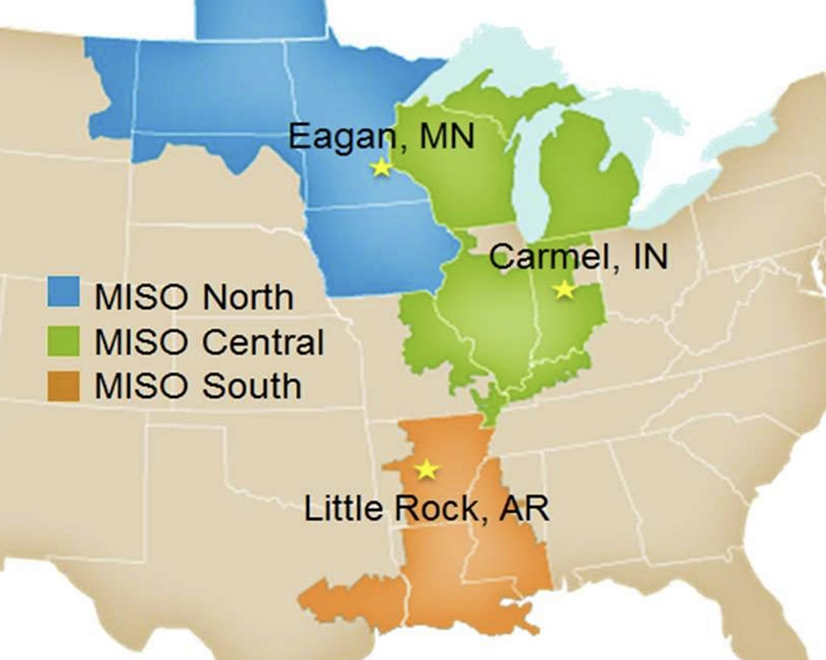
MISO stakeholders made it clear last week that a separate cost-allocation design for the South subregion’s long-range transmission projects will preserve the footprint’s most notorious constraint.
Several said during a Thursday conference call on cost allocation that maintaining one set of cost-sharing principles for MISO Midwest and another for MISO South would throw a wrench into any plans to expand the transfer capability between subregions.
WEC Energy Group’s Chris Plante said disparate allocations would further “balkanize” the Midwest from the South and make a healthier transmission link between the regions even more difficult to get built.
“I disagree with having different cost allocations between the North and South,” Lauren Azar, attorney for the Sustainable FERC Project, said. “I think just from a public policy perspective, we should be strengthening the ties between North and South. We need to bolster the resilience of MISO South.”
MISO has a 1,000-MW contract path bridging its Midwest and South subregions. Seven years ago, MISO and SPP reached an agreement setting a 3,000-MW limit on subregional transfers in the north-to-south direction and a 2,500-MW limit in the other direction. MISO sometimes exceeds those limits during emergency conditions but nearly always limits exceedances to the 30-minute grace period.
Staff in late July proposed using the 2011 Multi-Value Projects’ (MVP) allocation for the Midwest, which relies on a 100% uniform, “postage stamp” rate for load. The grid operator said it would wait to propose an alternative long-range cost allocation for MISO South. (See MISO Dusts off MVP Cost Allocation for Long-range Tx Plan.)
John Wolfram, a consultant representing transmission owner Hoosier Energy, said he didn’t think FERC would endorse bifurcated allocation methods for Midwest versus South.
“I think it will deter or serve as a barrier to increasing the transfer capability between North and South, which, frankly, should be a huge component” of the long-range transmission plan, he said.
“MISO as a whole will be much better off if it has one approach,” Clean Grid Alliance’s Natalie McIntire said in agreement. “I also think we’re much more likely to get approval from FERC if we have one allocation.”
The Coalition of Midwest Power Producers’ Travis Stewart said FERC has a history of rejecting filings that propose charging different rates for the same product. He said a case in point was MISO’s futile 2016 attempt to conduct separate three-year forward capacity auctions using a sloped demand curve only for a footprint’s deregulated areas.
Some stakeholders asked MISO to provide an example of how it would split costs using two types of cost allocation on projects that touch both the Midwest and South.
Michigan Public Service Commission Chair Dan Scripps said MISO’s MVP allocation “may very well be the devil you know” and pointed out that it already enjoys FERC approval.
MISO plans to file a cost allocation for long-term transmission projects sometime in late fall. Staff said a fall deadline will allow time for FERC to issue a decision before the first long-term transmission proposals are put before the MISO Board of Directors in March. (See related story, MISO Targets March Approval for Long-term Tx Projects.)
Entergy, Southern Regulators Offer Proposal
Entergy and MISO South regulators revealed their preference for long-term transmission cost allocation during the meeting. MISO Midwest uses an energy-based postage stamp allocation, but stakeholders requested a demand-based allocation with one of three criteria:
- an allocation to a regulatory body’s jurisdiction when a candidate project fulfills a policy need;
- allocation of a project candidate with “quantified economic benefits” to benefiting cost allocation zones; or
- a two-step allocation where project costs are first assigned to cost allocation zones that are found to have economic benefits; remaining costs are then dispersed to pricing zones that avoid developing reliability projects.
MISO South regulators and Entergy have also asked for a 1.25:1 benefit-to-cost ratio and 230-kV minimum voltage thresholds, greater than MISO’s 1:1 benefits ratio and 100-kV minimum. They both agree on a $20-million project cost threshold.
Some stakeholders pointed out that consistently high-load customers would benefit more from a demand-based allocation than an energy usage-based allocation.
Southern Renewable Energy Association Executive Director Simon Mahan said the MISO South proposal would allow Louisiana, with its heavy and constant industrial energy use, to “make out like a bandit.”
MISO is expected to adjust its allocation proposal based on the stakeholders’ discussion. The grid operator will hold another workshop on its long-range plan Aug. 27.


